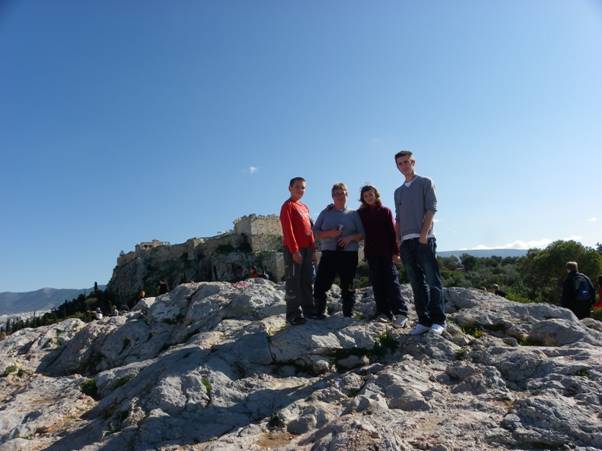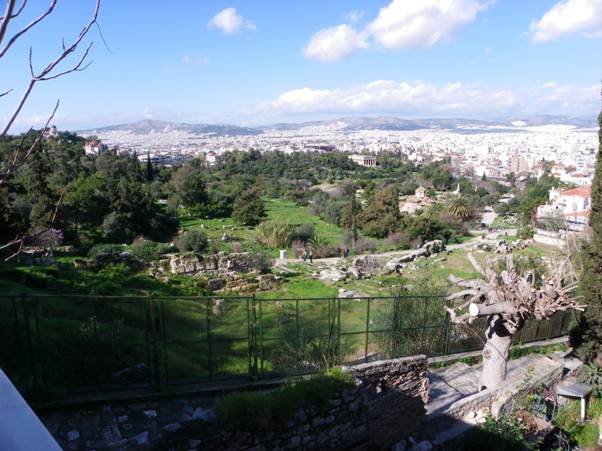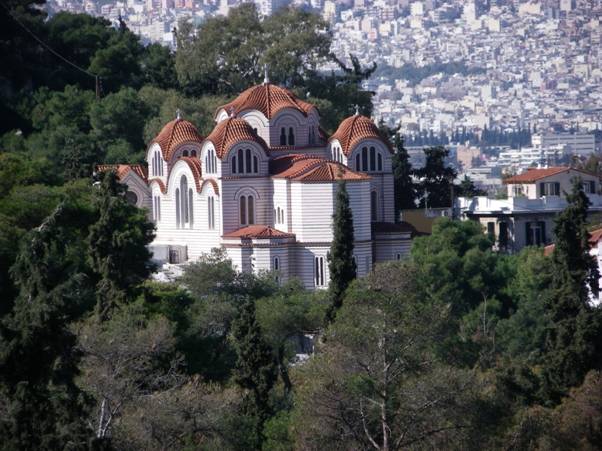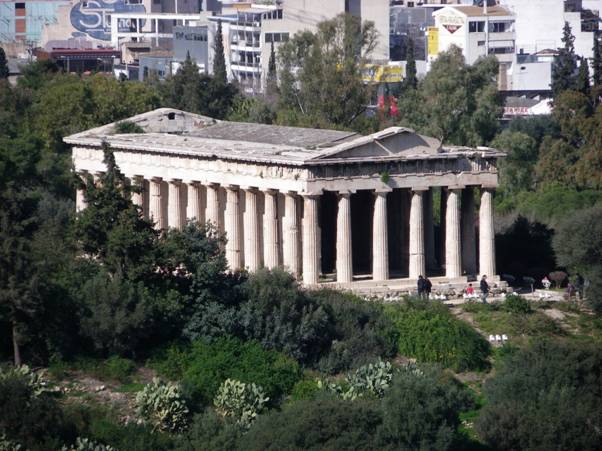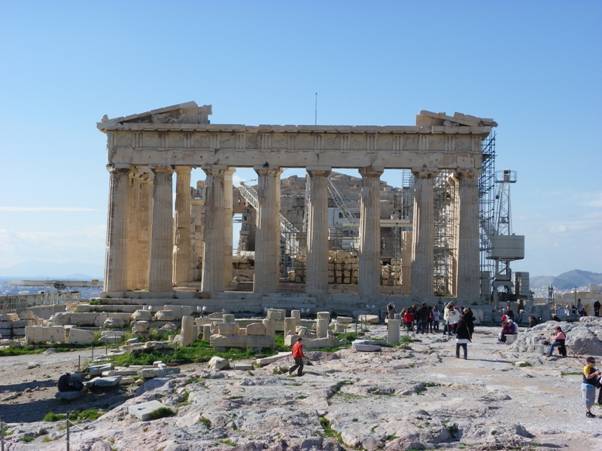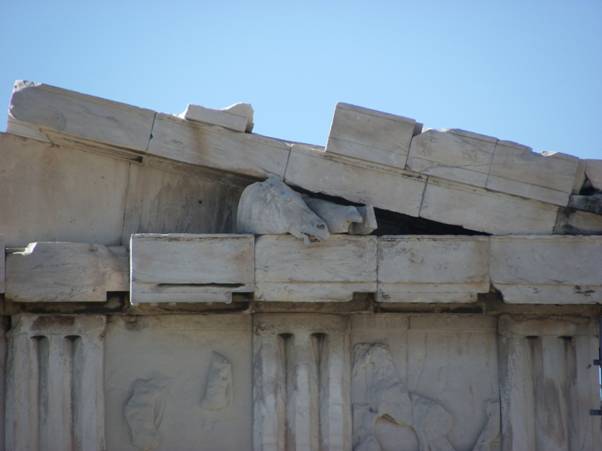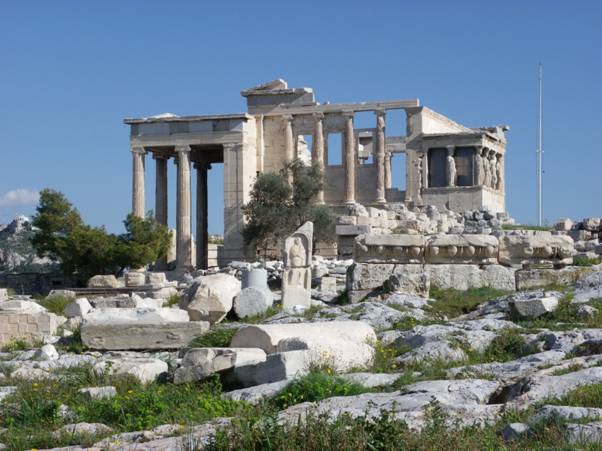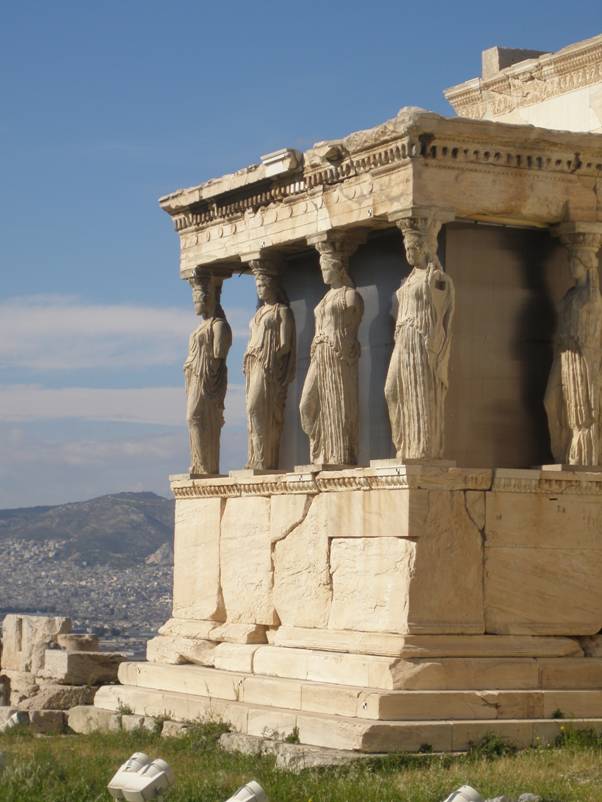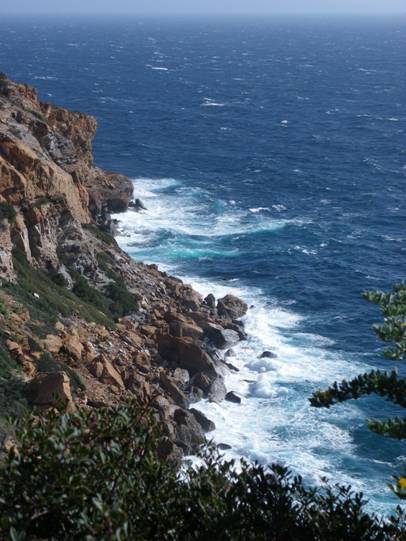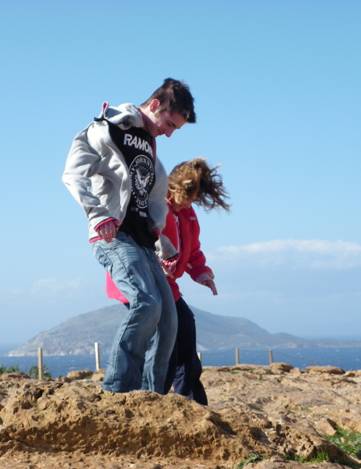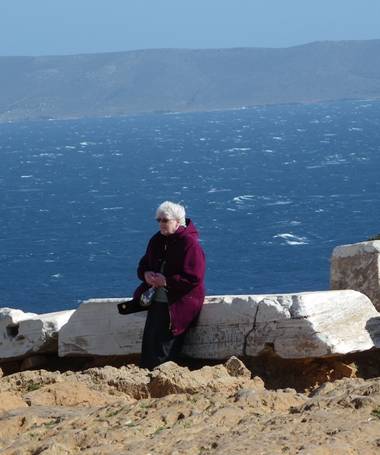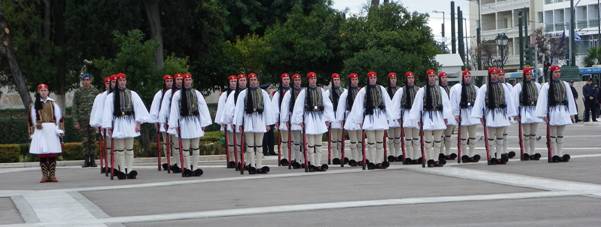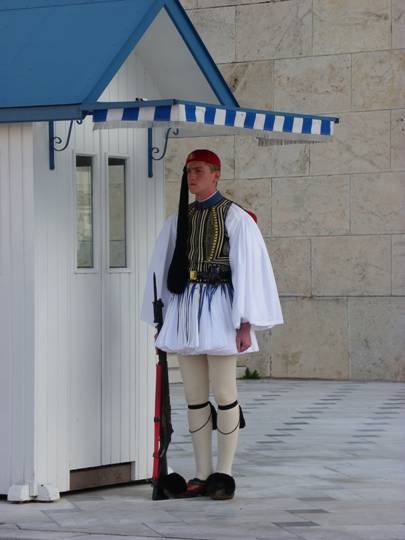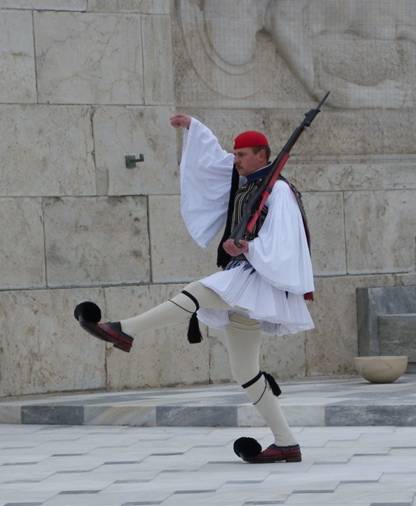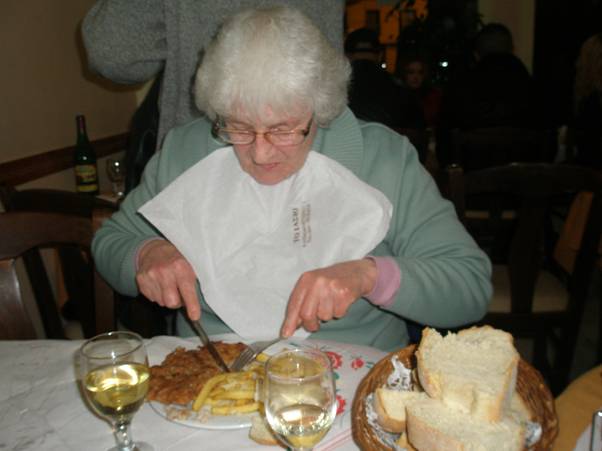Athens

|
Ruby (David’s Mum) and Luke (David’s 17-year-old son) flew out from
chilly Swansea to Athens to join us for a few days. As expected, the Acropolis
was top of our to-do list, and we had a sunny day with clear blue skies in which
to explore the site, in contrast to last time when we lost sight of the ancient
site behind a curtain of torrential rain. The Rock of Areopagos On our way up to the Acropolis, we climbed onto the Rock of Areopagos,
which is apparently where civil and criminal cases were heard in Athens in
Classical (ancient Greek) times, and where Saint Paul stood to address the
people of Athens in AD 51.
Bryn, Beth, Luke and me on the Rock of
Areopagos. From the Rock of Areopagos we looked down onto the site of the ancient Agora (the marketplace), a selection of Greek Orthodox churches and the Thission.
The site of the ancient Agora of Athens.
One of the Greek Orthodox churches.
The Thission. The
Thission is considered to be one of the best preserved Classical temples in
Greece. It was built in 449 BC and devoted to Hephaestus and Athena. Its frieze
depicts the exploits of Theseus.
The story
goes that King Minos (of the Minoans who lived on Crete) used to send out his
navy to plunder cities such as Athens. King Aegeus of Athens came to an
agreement with King Minos that Athens would be left alone if the city sent 7
boys and 7 girls to Crete every 9 years to be sacrificed to the Minotaur – a
flesh-eating man with a bull’s head. The Minotaur was held in a maze (the
Labyrinth) that had been specifically designed and built for this purpose by the
architect Daedalus and his son Icarus. Theseus,
who was the son of King Aegeus, announced that he was going to go with the
Athenian children destined for sacrifice and would try to kill the Minotaur. The
boat carrying Theseus and the children had a black sail and King Aegeus made
Theseus promise to fly a white sail on his way home – if he lived.
When they
got to Crete, King Minos and his daughter, Ariadne, came out to see the
sacrifices and Ariadne fell in love with Theseus. Desperate to save Theseus,
Ariadne asked Daedalus how Theseus might find his way in to kill the Minotaur
and then find his way back out. Taking Daedalus’ advice, Ariadne gave Theseus a
sword with which to kill the Minotaur, and a ball of string to unroll as he went
into the Labyrinth so that he could find his way back. Theseus promised to marry
her if he escaped without being eaten. The next
day, everything went according to plan; Theseus found his way to the centre of
the Labyrinth, killed the Minotaur, followed the string back to the entrance,
Ariadne opened the door for them, and they all escaped to the ship and sailed
away. On the way home, the ship stopped at the island of Delos for everyone to
rest. Theseus left Ariadne asleep on the island and carried on to Athens without
her (such a gentleman...). When the
ship got to Cape Sounion it was spotted by King Aegeus who was looking out for
its return. Unfortunately, Theseus had forgotten to change the sail from black
to white, and when King Aegeus saw the black sail he thought that Theseus was
dead, and he threw himself off the cliff. Meanwhile, back in Crete,
King Minos found out what Daedalus had done and imprisoned Daedalus and Icarus
in the Labyrinth. It was while trying to escape from the Labyrinth that Icarus
flew too close to the sun and melted the wax holding the feathers in his wings –
he fell into the sea and drowned. Daedalus made it safely to Sicily while
Icarus' body was carried ashore by the current to a small island near Samos,
which was then named after him – Ikaria.
Bryn and Luke in cool
mode; Bryn resting his hand on Lycabettus Hill. The Acropolis Acropolis means ‘upper
city’ and apparently many of the city states of ancient Greece were built around
an acropolis where the people could go as a place of refuge when they were being
attacked. In Athens, the Parthenon and other main buildings on the Acropolis
were built by Pericles in the 5th century BC in honour of the
cultural and political achievements of the people of the
city. The Propylaea On climbing
the steps up to the Acropolis, the first building that you come to is the
entrance or Propylaea. Apparently somewhere here among the scaffolding there is
a tiny temple to Nike Athena (‘nike’ meaning ‘victory’), which commemorates the
Athenians victory over the Persians.
The
Propylaea. The Parthenon The
Parthenon is probably one of the most recognizable structures in the world. It
was designed by the architects Kallikrates and Iktinos to house a giant statue
of Athena, and was completed in 438 BC. First used as a temple, it then became a
church, a mosque, and finally a store for Turkish gunpowder. It was blown up by
the Venetians in 1687 AD, when a cannonball hit the gunpowder. Apparently, each
piece of the Parthenon is unique and the pieces fit together like a big, heavy,
3D jigsaw puzzle.
Bored child in front of the Parthenon (1).
Bored child in front of Parthenon (2). Despite the fact that it bristles with scaffolding and is destined to be
a never-ending restoration project, there is no doubt that the Parthenon is a
very impressive building; the size of the people next to it give an idea of its
huge scale. Apparently
there used to be a marble frieze around the top outside edges on all sides, and
3D statues in the east and west pediments (the triangular bits at the front and
back). The external
marble frieze (made of metre-high slabs or ‘metopes’) depicts scenes from Greek
mythology in deep relief. ·
At the front (east)
of the temple there are scenes from a battle between the gods and the giants
(known as the Gigantomachy). ·
The back (west) of
the temple shows fights between the Greeks and the Amazons (the
Persians). ·
The north has scenes
from the Trojan War. ·
The south illustrates
the battle between the Centaurs and the Lapiths (known as the
Centauromachy). The common theme for
all of the marble work was the triumph of civilization over barbarism, as the
Athenians believed that they were superior to other cultures of their time.
Fragments of a horse’s head showing where the decoration used to be on
the east and west pediments of the Parthenon. Inside the Parthenon,
a low-relief marble frieze ran around the outside of the ‘cella’ – the building
that contained the statue of Athena. This frieze shows the people of Athens
(musicians, soldiers on horseback, elders, animals for sacrifice) in procession,
with the Olympian gods seated. This frieze would (so our guide book said) have
been decorated in vivid colours, with metal spears and swords for the soldiers,
and metal bits for the horses. When the early Christians came along they systematically defaced most of the sculptures (chipped off all of the nipples and penises) when they converted the Parthenon into a church. We saw fragments (the bits that survived, not the penises and nipples) and copies of these marble statues in the Acropolis Museum – with gaps left for the missing bits (e.g. the Elgin Marbles).
Bored child in front
of Greek flag on the Acropolis. Seeing
the Greek flag flying above a gun emplacement was a stark reminder that the
Acropolis was as much a fortress as a religious site. When the Germans occupied
Athens in WWII, the Evzone who guarded the flag was ordered by the Nazis to
remove it. He is reputed to have taken it down calmly, wrapped himself in it and
jumped to his death.
It’s that ancient LEGO again... The Erecthion The
Erecthion marks the most sacred site of the Acropolis where the gods Poseidon
and Athena had a contest to see who would be the Patron of the city. Poseidon
poked his trident into the rock and a spring erupted, while Athena touched the
ground with a spear and an olive tree grew. Athena was declared the victor and
the city of Athens was named for her. It is this building that contains the
porch with (copies of) the famous maidens or Caryatids. We saw four of the
Caryatids in the Acropolis museum – they are amazing and each one is different.
Lord Elgin acquired the fifth for the British
Museum.
The Erecthion.
The
Caryatids. The Temple to Poseidon at Sounion All
6 of us squished into our hire car and we drove SE to Cape Sounion to see the
Temple to Poseidon.
This site was first mentioned in Homer’s Odyssey as the place where
Menelaus stopped on his way back from Troy to bury his helmsman, Phrontes
Onetorides
(remember that one for the test). There is also a Temple to Athena nearby.
The
Temple to Poseidon at Sounion. The
current temple was built in 444 BC and consisted of 34 Doric columns, of which
15 have survived. The columns (according to www.sacred-destinations.com) were
cut with only 16 flutings instead of the usual 20, to reduce the surface area
exposed to the erosive effects of wind and water. The
temple frieze – now badly eroded – supposedly shows scenes from the battle of
the Centaurs and Lapiths, and Theseus’ exploits (Theseus was Poseidon’s son in
some versions of Greek mythology). Lord
Byron was an early visitor to the temple, and left his mark – carved into the
marble of one of the columns in 1810. Unfortunately this gave other visitors the
same idea and the temple is now covered in graffiti from down the ages. You
aren’t allowed to clamber on the actual temple any longer, so we couldn’t go
hunting for Byron’s signature. The
setting for the temple – on top of the cliffs at Cape Sounion and overlooking
the Aegean – is rugged and isolated.
Looking
out over the Aegean from Cape Sounion.
It
could have been from these cliffs that King Aegeus (Theseus’ Dad)
chucked himself when he saw the ship with black sails on its way back from
Crete. It
was very windy the day we were there – so windy that we could hardly stand
up.
Beth and Luke being blown away.
Ruby
getting windswept. We
made a toast to Poseidon (we sailors are a superstious bunch) with wine/peach
juice in plastic cups before moving on to find a deserted beach nearby (well it
was going to be deserted on a cold, windy day in February) to have our
picnic.
Bryn
making sandwiches using a Swiss Army knife on a bench near the
beach. The
Evzones On Sunday
morning we hung around the Greek Parliament Building in Athens to catch the
changing of the guard. At the allotted time (most unlike Greece), the traffic
was stopped and the police took great delight in shouting at all of the tourists
and making them move back to stand behind a specific set of paving stones.
The
Evzones. The Evzones
are an elite ceremonial unit that guards the Greek Tomb of the Unknown Soldier,
the Parliament Building and the Presidential Mansion. Drawn from the among the
tallest of the Greek soldiers, they dress in a unique traditional uniform based
on that worn by guerrilla fighters during the Ottoman occupation – basically
white tights, a white kilt (with 400 pleats to mark the 400 years of Ottoman
occupation), a white shirt with bell-shaped sleeves, an embroidered waistcoat, a
red, fez-like hat with long black tassel, and red clogs with black pompoms. (I
bet those tights are made of wool and itch like crazy in the summer.) Apparently
the Evzones only have to wear this little lot on specific occasions and can slob
around in standard khaki uniforms the rest of the
time.
An Evzone on guard. The Evzones have a distinctive high-kicking, slow-motion march (reminiscent of John Cleese doing a funny walk) that has to be perfectly co-ordinated with their fellow soldiers – it must take a huge amount of strength and control.
An Evzone in action. Gyros When we weren’t doing temples, museums or Evzones, we got to grips with
the Athens metro, found some interesting places to eat (Arabic and Romanian as
well as Greek) and introduced Luke and Ruby to gyros.
Ruby going Romanian.
Beth and Luke tackling pork steak and Romanian
schnitzel. Still more to come on Ancient Olympia and
Kalavryta. |
